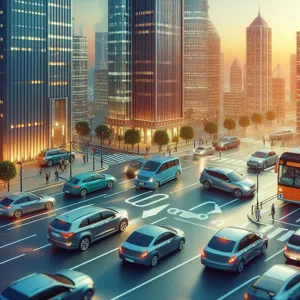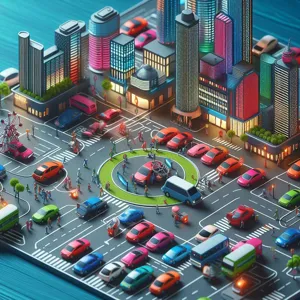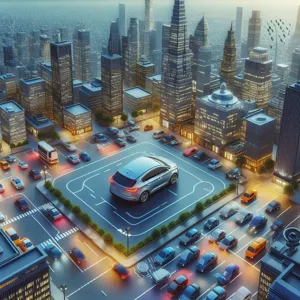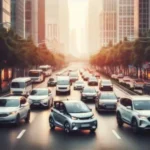Navigating the bustling streets of a crowded city can often feel like an Olympic event, with the challenge of finding a parking spot adding an extra layer of stress to your journey.
Whether you’re rushing to an important meeting, headed to a dinner with friends, or simply running errands, the quest for parking can transform an otherwise pleasant outing into a frustrating ordeal. But fear not! With a few strategic tips and tricks up your sleeve, you can master the art of parking like a pro. In this blog post, we’ll explore clever techniques for spotting that elusive parking space, understanding the nuances of city parking regulations, and utilizing technology to your advantage. Get ready to reclaim your time and reduce your stress as we delve into the essential skills needed to conquer the urban jungle and find your perfect parking spot with ease!
1. Understanding the Challenges of Urban Parking

Parking in a bustling city can often feel like a high-stakes game of musical chairs, where the music never truly stops and finding a seat is a constant struggle. Urban environments are notorious for their limited parking options, with dense populations, busy streets, and an influx of visitors all vying for the same scarce spaces. Understanding the challenges of urban parking is the first step towards mastering the art of finding that coveted spot.
One of the primary hurdles is the sheer volume of vehicles on the road. In many cities, the ratio of cars to available parking spots can be outrageously skewed, leading to long searches and sometimes even frustration that can sour the experience of a day out. Furthermore, the regulations and rules governing parking can vary significantly from one block to the next, adding an additional layer of complexity. From metered spots with strict time limits to residential permit zones, deciphering the parking landscape can feel like navigating a maze.
Moreover, the time of day plays a crucial role in parking availability. Morning rush hours and evening events can create peak demand, making it even more challenging to secure a space. Weekends may bring an influx of shoppers or tourists, further complicating the search. It’s essential to stay informed about local events, construction projects, and seasonal fluctuations that might impact parking availability.
Technology has provided some relief, with apps and websites that offer real-time information on parking availability and prices. However, even with these tools, the unpredictability of urban parking remains a daunting challenge. By recognizing these obstacles, drivers can adopt proactive strategies and mental preparedness, transforming the often frustrating search for parking into a more manageable—and even successful—endeavor.
2. Plan Ahead: Researching Parking Options
When navigating the bustling streets of a crowded city, planning ahead is essential for a smooth parking experience. Before you even set foot outside your door, take some time to research the parking options available in your destination area. This proactive approach can save you time, stress, and even money.
Start by checking online resources such as parking apps and websites that provide real-time information about available spots. Many cities now offer mobile applications that not only show you where to find parking but also allow you to reserve a space in advance. This can be an absolute lifesaver, especially during peak hours or at popular events.
Additionally, consider the various types of parking facilities available—street parking, public garages, and private lots each come with their own set of rules, fees, and availability. Familiarize yourself with the parking regulations in your chosen area to avoid fines or costly towing. Websites like Parkopedia or SpotHero can be invaluable, giving you insights into pricing, hours of operation, and user reviews of different parking locations.
Another useful tip is to explore less conventional parking options, such as designated lots for rideshare services or nearby commercial establishments that allow public parking after hours. Some businesses even partner with parking apps to offer discounted rates for their patrons.
Lastly, if you’re frequenting a particular area, consider talking to locals or joining community forums to gain insider tips on the best parking spots. Regular visitors often have valuable insights about hidden gems that are less known to tourists but perfect for avoiding the crowd.
By investing a little time in research before you leave, you’ll be better equipped to find a parking spot that suits your needs, making your city experience much more enjoyable and hassle-free.
3. Utilizing Parking Apps and Technology

In today’s fast-paced urban environment, where every minute counts, utilizing parking apps and technology can be a game changer for drivers navigating crowded city streets. These innovative tools take the guesswork out of parking, ensuring you spend less time circling the block and more time enjoying your destination.
Several parking apps, such as SpotHero, ParkWhiz, and ParkMobile, allow you to search for available spots in real-time, compare prices, and even reserve your parking space in advance. Imagine driving into the city and knowing exactly where to go, all while avoiding the frustration of endless searching. These apps provide crucial information, including user ratings, distance from your location, and even estimated walking times to your final destination.
Moreover, many cities have embraced smart parking technology, incorporating sensors that monitor real-time availability in parking lots and garages. These sensors can send alerts directly to your smartphone, helping you locate the nearest open spot with minimal effort. Some apps even utilize GPS technology to guide you directly to your chosen parking location, turning what used to be a stressful experience into a seamless journey.
Beyond just finding a spot, these apps often offer advanced features such as payment processing, allowing you to pay for your parking on the go without fumbling for coins or worrying about expired meters. Many also send notifications when your time is about to expire, giving you the option to extend your parking session remotely, thus avoiding costly tickets and the anxiety of rushing back to your car.
By leveraging parking apps and technology, you can transform the often tedious task of finding parking into a streamlined process, leaving you free to focus on what really matters—enjoying your time in the city. With these tools at your fingertips, you’ll be equipped to conquer even the busiest urban areas with ease.
4. Timing is Everything: Best Times to Find Parking
When it comes to navigating the often chaotic landscape of urban parking, timing can be your secret weapon. Knowing the best times to hunt for a parking spot can make all the difference between a stress-free experience and a frustrating ordeal. Generally, the early bird truly does catch the worm—or in this case, the parking space.
Weekday mornings, especially before 9 AM, are typically less congested, as many commuters are still at home getting ready for the day. If you can rise early, you’ll find a greater availability of spots, especially near popular business districts or downtown areas. Conversely, late mornings, especially around lunchtime, see a surge in foot traffic as people flock to cafes and restaurants, making parking harder to come by.
Another optimal time to consider is late afternoon and early evening—around 6 PM—when most workers are heading home. Interestingly, this can also be a prime time for vacated spots as people finish their workday and leave their offices. If you can time your arrival to coincide with this exodus, you might snag a spot just as one opens up.
Weekends often bring their own set of challenges, with brunch and shopping crowds vying for limited spaces. However, if you can plan your outings for earlier in the day or later in the evening, you’ll likely find more room to maneuver. Additionally, special events or public holidays can significantly impact parking availability, so always check local calendars before heading out.
Lastly, consider utilizing apps that provide real-time parking information. These tools can alert you to open spots and even allow you to reserve a space in advance, saving you time and hassle. By mastering the timing of your parking endeavors, you’ll not only reduce stress but also gain a competitive edge in the quest for that elusive spot in the city.
5. The Art of Parallel Parking: Techniques and Tips

Parallel parking can often feel like an intimidating dance, especially in the tight confines of a crowded city. However, mastering this essential skill can make all the difference between a stress-free experience and a frustrating search for a parking spot. As daunting as it may seem, with the right techniques and a little practice, you can become a parallel parking pro.
To begin, ensure you have enough space to maneuver. Look for a spot that is at least one and a half times the length of your vehicle. Once you’ve identified your ideal parking space, signal your intent to park and slow down. Position your car parallel to the vehicle parked in front of the space you wish to occupy, keeping about two feet of distance between the two cars.
Next, it’s time to engage the magic of angles. Shift your car into reverse while turning your steering wheel towards the curb. As the rear of your vehicle begins to enter the space, keep an eye on the front of your car to avoid clipping the bumper of the car in front. When your front tires clear the back of the parked car, straighten your wheel and continue reversing until your vehicle is fully in the space.
Once you’re in the spot, make sure to adjust your position if necessary. This often means moving forward or backward to ensure you’re centered between the vehicles on either side. A good rule of thumb is to ensure you’re about six to twelve inches from the curb, but not so close that you risk a tire bump or hitting the curb itself.
Lastly, don’t forget to check your mirrors before exiting your vehicle. This ensures you’re not blocking any traffic and that you’re parked correctly. With a bit of practice and confidence, parallel parking can transform from a dreaded task into an effortless maneuver, allowing you to navigate the urban jungle with ease. So, the next time you’re faced with a crowded street, remember these techniques and embrace the art of parallel parking!
6. Exploring Alternative Parking Solutions (e.g., garages, lots)
In the hustle and bustle of crowded cities, finding a parking spot can often feel like searching for a needle in a haystack. However, exploring alternative parking solutions can alleviate much of that stress and provide you with more convenient options. While on-street parking may be the most visible option, it can quickly become a game of chance, especially during peak hours. Enter garages and parking lots—these hidden gems can save you time and frustration.
Many urban areas boast an array of parking garages and lots, often located just a short stroll away from your destination. These facilities typically offer a variety of pricing options, including hourly, daily, and even monthly rates, catering to different needs. Some garages may even provide discounted rates for early bird parkers or special deals for regular visitors. Utilizing apps and websites that provide real-time information about available spots and pricing can help you make informed decisions and avoid unnecessary driving around.
Furthermore, don’t overlook the benefits of private lots. While they may be less well-known, many businesses and residential buildings offer parking spaces for rent. This can be particularly advantageous during events or busy weekends when public parking options are limited. Consider reaching out to local businesses or exploring community bulletin boards for potential leads on available spaces.
Lastly, as we embrace the sharing economy, peer-to-peer parking services are becoming increasingly popular. These platforms connect drivers with individuals who have extra parking space available, allowing you to find a spot that’s not only convenient but often more affordable. Exploring these alternative solutions can transform your parking experience from a daunting task into a seamless part of your city adventure. So, the next time you’re navigating through a crowded urban landscape, remember that the perfect parking spot might just be a few blocks away, waiting to be discovered.
7. The Benefits of Carpooling and Public Transportation

In the hustle and bustle of a crowded city, finding a parking spot can often feel like searching for a needle in a haystack. However, one of the most effective strategies to ease the parking dilemma is to embrace carpooling and public transportation. Not only do these alternatives alleviate the stress of parking, but they also come with a multitude of benefits that extend beyond convenience.
Carpooling is a fantastic way to share the journey with others, effectively reducing the number of vehicles on the road. Picture this: instead of each person driving separately and circling the blocks in search of that elusive parking space, a group of friends or colleagues can ride together, enjoying each other’s company and cutting down on fuel costs. This not only minimizes the time spent looking for parking but also contributes to a reduction in traffic congestion and carbon emissions, making it an eco-friendly choice.
Public transportation offers a similar solution, providing a reliable and often cost-effective means of getting around the city. Buses, trains, and subways can whisk you directly to your destination without the hassle of parking altogether. With cities investing in expanding their public transit systems, more routes and services are becoming available, making it easier than ever to navigate urban landscapes. Plus, using public transport can give you the luxury of time; instead of focusing on parking, you can catch up on reading, listen to podcasts, or simply enjoy the scenery.
Additionally, both carpooling and public transportation can lead to significant savings. The costs associated with gas, parking fees, and vehicle maintenance can quickly add up, but by sharing rides or opting for transit, you can keep more money in your pocket. Many cities also offer incentives for carpoolers, such as access to high-occupancy vehicle lanes or discounted tolls, making it an even more appealing option.
In conclusion, by embracing carpooling and public transportation, you not only simplify the process of getting around a crowded city but also contribute to a more sustainable and cost-effective lifestyle. So the next time you’re faced with the daunting task of finding a parking spot, consider rallying some friends or hopping on the bus—you might just find that the journey is as enjoyable as the destination.
8. Creative Strategies for Finding Street Parking
Finding street parking in a bustling city can often feel like an Olympic sport, requiring a unique blend of strategy, patience, and a bit of luck. However, with a few creative strategies up your sleeve, you can significantly increase your chances of scoring that coveted spot.
One effective tactic is to think outside the box when it comes to timing. Instead of driving around during peak hours, consider planning your trips for off-peak times. Early mornings or late evenings are often less congested, and you might find that street spaces are more readily available. Additionally, many cities have street cleaning schedules that can temporarily free up parking spaces, so being aware of these can help you plan your visit accordingly.
Another clever approach is to utilize technology to your advantage. Various apps and websites can provide real-time information about available parking spaces in your area. These platforms often highlight spots that are currently open, as well as those that are likely to become available soon due to timed parking restrictions. By using these tools, you can save time and reduce the frustration of endlessly circling the block.
Don’t overlook the power of strategic observation. As you navigate city streets, keep an eye out for parking signs that indicate time-limited spaces. If you’re able to spot a car pulling out of a spot, be quick to seize the opportunity—it’s often the case that other drivers may miss out on these fleeting chances because they’re too focused on their own search. Additionally, consider looking for spots slightly further away from your destination. Many city dwellers are hesitant to walk a little extra, so you may find parking a block or two away that others have overlooked.
Lastly, developing a keen sense of local parking trends can be invaluable. Frequent visitors to certain neighborhoods often learn the best times and locations for parking, so don’t hesitate to ask locals for tips. Whether it’s a nearby café owner or a friendly passerby, gaining insight from those who know the area can lead you to hidden gems that are not immediately apparent.
By employing these creative strategies, you can transform the daunting task of finding street parking into a more manageable and even enjoyable experience. With a little preparation and a willingness to adapt, you’ll be mastering the art of parking in no time!
9. The Importance of Knowing Local Parking Regulations
When navigating the bustling streets of a crowded city, understanding local parking regulations can make all the difference between a seamless experience and a frustrating ordeal. Each city has its unique set of rules, and these can vary not only from one neighborhood to another but also from one street to the next. Familiarizing yourself with these regulations is crucial for avoiding costly fines and ensuring that your vehicle remains safe and secure.
Start by researching the specific parking laws in your area. Are there restrictions on parking during certain hours? Is street cleaning scheduled, and if so, when? Many cities employ a mix of metered parking, residential permits, and time-limited spots, each with its own set of rules. For instance, failing to adhere to time limits can lead to tickets, while parking in a permit-only zone can result in towing.
Utilizing apps and websites that provide real-time information on parking regulations can be invaluable. These tools often include maps that highlight available parking zones, meter rates, and even local events that might affect parking availability. Additionally, keeping an eye out for clear signage is essential; parking regulations are often posted on nearby poles or at the entrance of parking lots.
Moreover, being aware of seasonal changes in parking rules is equally important. For example, some cities may implement winter parking bans to ensure snow removal, while summer festivals may lead to temporary changes in parking availability.
Ultimately, knowing local parking regulations not only saves you from fines but also enhances your overall parking experience, allowing you to focus on what really matters—enjoying the vibrant life of the city. With these insights in hand, you’ll be better equipped to find a spot, avoid unnecessary headaches, and master the art of parking in even the most crowded urban environments.
10. How to Stay Calm and Patient While Searching for Parking
Finding parking in a bustling city can often feel like an exercise in frustration, but mastering the art of staying calm and patient can transform this challenge into a more manageable task. The key is to approach the situation with a mindset of resilience and adaptation. First and foremost, take a deep breath. Remind yourself that the search for a parking spot is just a small part of your day, and losing your cool won’t make the space magically appear.
Set realistic expectations before you hit the road. Be aware that in a crowded urban environment, it may take longer than anticipated to find a spot. Instead of racing against the clock, allocate some extra time for parking in your schedule. This way, you’ll be less inclined to rush and more open to exploring your options as you navigate the streets.
Use technology to your advantage. Many cities now have parking apps that provide real-time information about available spots, rates, and even recommendations based on your location. These tools can reduce the time spent circling the block and help you stay informed about the best places to park. If you find yourself in a particularly congested area, consider parking a little further away and walking to your destination. Not only does this often lead to easier parking, but it also gives you the chance to enjoy the urban landscape and perhaps discover a new coffee shop or boutique on the way.
Lastly, maintain a positive attitude. Instead of viewing the search for parking as a nuisance, treat it as an opportunity to practice mindfulness. Listen to your favorite music or podcast, or use this time to reflect on your day ahead. By shifting your perspective and embracing the journey, you’ll find that a little patience goes a long way in reducing stress and enhancing your overall city experience.
11. Tips for Avoiding Parking Tickets
Navigating the bustling streets of a crowded city can be challenging enough without the added stress of parking tickets. To help you master the art of parking and keep your wallet intact, here are some essential tips for avoiding those pesky fines.
Firstly, always pay close attention to parking signs. Cities often have complex regulations, and what might seem like a convenient spot can quickly turn into a ticket trap if you misinterpret the rules. Look for signs that indicate time limits, street cleaning schedules, or permit requirements. Taking a moment to read these can save you from an unexpected fine.
Additionally, consider using parking apps that provide real-time updates on available spots and their associated rules. These apps can alert you to any changes in parking regulations and guide you to areas where you can park legally without the fear of retribution. Set reminders on your phone to ensure you don’t overstay your welcome—if the meter runs out, so does your luck!
Another vital tip is to familiarize yourself with the area you’re parking in. Some neighborhoods may have stricter rules than others, so knowing the local customs can help you avoid mistakes. If you’re unsure, it’s always better to err on the side of caution and find a more secure parking option.
Finally, when in doubt, opt for garages or lots. While they may come with a fee, they often provide peace of mind and can be a worthwhile investment compared to the cost of a ticket. Plus, many garages allow you to reserve a spot in advance, ensuring you won’t be left circling the block.
By staying vigilant, utilizing technology, and understanding the local parking landscape, you can effectively dodge parking tickets and enjoy a hassle-free experience in the city. Mastering these tips will keep your focus where it should be—on the adventure ahead, rather than the fines behind you.
12. Eco-Friendly Parking: Considerations for the Environment
As urban areas continue to grow, the impact of vehicle congestion on the environment becomes increasingly significant. Mastering the art of parking isn’t just about finding a spot; it’s also about making choices that are considerate of our planet. Eco-friendly parking practices can help reduce your carbon footprint and contribute to a cleaner, healthier environment.
When searching for a parking spot in a crowded city, consider opting for lots or garages that prioritize sustainability. Many urban centers are now equipped with electric vehicle (EV) charging stations, allowing you to power your car while you shop or attend an event. By choosing these eco-friendly options, you’re not only supporting the infrastructure for electric vehicles but also taking a step toward reducing air pollution.
Another important consideration is the use of public transportation or rideshare services when possible. Often, parking can be a headache in busy areas, and relying on buses, trains, or rideshares can help alleviate that stress while minimizing the number of cars on the road. If you do need to drive, try to park at locations slightly outside the busy areas and walk or bike the remaining distance. This not only decreases your environmental impact but also allows you to explore and appreciate the city in a more intimate way.
Additionally, look for parking facilities that practice green initiatives, such as rainwater harvesting, solar panels, or eco-friendly building materials. By choosing to park in these eco-conscious locations, you’re supporting businesses that prioritize sustainability and encouraging more establishments to adopt similar practices.
Ultimately, eco-friendly parking is about making informed decisions that benefit both you and the environment. By being mindful of where and how you park, you can contribute to a greener future while mastering the complexities of urban parking.
13. Learning from the Locals: Insights and Tricks
When it comes to mastering the art of parking in a crowded city, there’s no better resource than the locals who navigate these bustling streets daily. They possess a wealth of knowledge, honed through years of experience, that can be invaluable for anyone trying to find a parking spot in a busy urban environment. Tapping into their insights can turn a frustrating ordeal into a manageable task.
Start by striking up conversations with residents, whether it’s at a coffee shop or while waiting in line. Locals often have their favorite parking spots, tucked away in less obvious locations or off-the-beaten-path areas that may not appear in conventional guides. They might share hidden gems where parking is more accessible, such as side streets, community lots, or even nearby businesses that allow customers to park for a short time.
Additionally, many cities have unique parking regulations that can be daunting for newcomers. Locals can offer tips on understanding the signage, such as deciphering street cleaning schedules or knowing when spots are available without the risk of a ticket. They might also let you in on the best times to park, revealing that certain areas might be free or less congested during specific hours of the day or week.
Don’t forget about the digital age—locals are often plugged into apps and social media groups that provide real-time updates on parking availability. Joining these communities can keep you in the loop and help you snag a spot before it disappears. Plus, many cities have dedicated platforms where residents share their experiences, including warnings about particularly tricky areas or times to avoid.
Incorporating the wisdom of locals not only enhances your parking strategy but also fosters a sense of community. By learning their tricks and tips, you’ll not only improve your parking prowess but also gain a deeper appreciation for the city you’re navigating. So next time you find yourself searching for a parking spot, remember: the locals are your best resource. Listen, learn, and park like a pro!
14. The Future of Urban Parking: Trends and Innovations
As cities continue to grow and evolve, so too does the landscape of urban parking. The future of parking in crowded urban areas is set to be shaped by a wave of innovative trends that not only aim to alleviate the stress of finding parking but also enhance the overall urban experience. Here are some key developments to watch for:
**Smart Parking Solutions:** The integration of technology is revolutionizing how we approach parking. Smart parking systems utilize sensors and real-time data to help drivers locate available spaces quickly. Apps that guide users to nearby parking spots and provide information on pricing and availability are becoming commonplace. Imagine cruising through the city while your smartphone directs you to the nearest open spot, saving you time and reducing the frustration of circling the block.
**Automated Parking Garages:** The advent of automated parking garages is another exciting trend. These facilities use robotic systems to park vehicles, maximizing space and efficiency. By eliminating the need for drivers to maneuver their cars into tight spots, these garages can increase parking capacity and significantly reduce the time spent searching for a space. This innovation not only streamlines the parking process but also minimizes the environmental impact by reducing emissions from idling vehicles.
**Emphasis on Multi-Modal Transportation:** As urban planners prioritize sustainable mobility, the future of parking also involves a shift towards multi-modal transportation options. Cities are increasingly encouraging the use of bicycles, public transit, and ride-sharing services. This means that parking infrastructure will need to adapt, with more designated spaces for bikes, electric vehicle charging stations, and partnerships with ride-sharing platforms to provide convenient pick-up and drop-off zones.
**Dynamic Pricing Models:** Another trend gaining traction is dynamic pricing for parking. Rather than flat fees, prices may fluctuate based on demand, time of day, and location. This approach not only encourages drivers to seek alternatives during peak times but also helps manage congestion and ensures that parking spaces are utilized more efficiently.
**Sustainability Initiatives:** With a growing emphasis on sustainability, future parking solutions are likely to incorporate green practices. From solar-powered parking lots to permeable paving that reduces runoff, eco-friendly designs will play a crucial role in urban planning. Additionally, parking facilities may include green spaces or community areas, transforming them from mere storage locations for vehicles into vibrant parts of the urban landscape.
In conclusion, the future of urban parking is poised for transformation, driven by technology, sustainability, and a holistic approach to transportation. As these trends continue to develop, they offer promising solutions to the age-old challenge of finding a parking spot in bustling cities. Embracing these innovations will not only make urban parking more efficient but also enhance the quality of life for city dwellers and visitors alike.
15. Conclusion: Embracing the Urban Parking Experience
As we conclude our exploration of urban parking, it’s essential to embrace the unique challenges and opportunities that come with navigating the bustling streets of a crowded city. Parking in these vibrant environments may often feel like a daunting task, but with the right mindset and strategies, it can transform into an engaging part of your urban experience.
The key is adaptability; cities are constantly evolving, and so are parking solutions. Whether it’s leveraging technology through parking apps, exploring alternative transportation methods, or simply perfecting your timing, being proactive in your approach can turn parking from a hassle into a seamless aspect of your journey.
Moreover, remember that parking is not just about finding a spot—it’s an opportunity to discover new neighborhoods, local favorites, and hidden gems. Each time you hunt for parking, you’re presented with a chance to immerse yourself in the city’s character, meet new people, and perhaps stumble upon a quaint café or a unique shop you might not have otherwise noticed.
So, the next time you find yourself circling the block in search of that elusive parking space, take a deep breath and embrace the adventure. With patience, persistence, and a dash of creativity, you can master the art of parking, turning a seemingly mundane task into a rewarding part of your urban exploration. After all, in the heart of the city, the journey is just as important as the destination. Happy parking!
Navigating the bustling streets of a crowded city can often feel like a daunting task, especially when it comes to finding a parking spot. We hope this blog post has equipped you with practical tips and strategies to master the art of parking, turning a potentially frustrating experience into a seamless part of your urban adventures. From exploring alternative parking options to timing your visits just right, these insights will empower you to reclaim your time and reduce the stress of city driving. As you venture out into the vibrant cityscape, remember that a little planning can go a long way. Happy parking, and may your next city outing be filled with ease and excitement!






